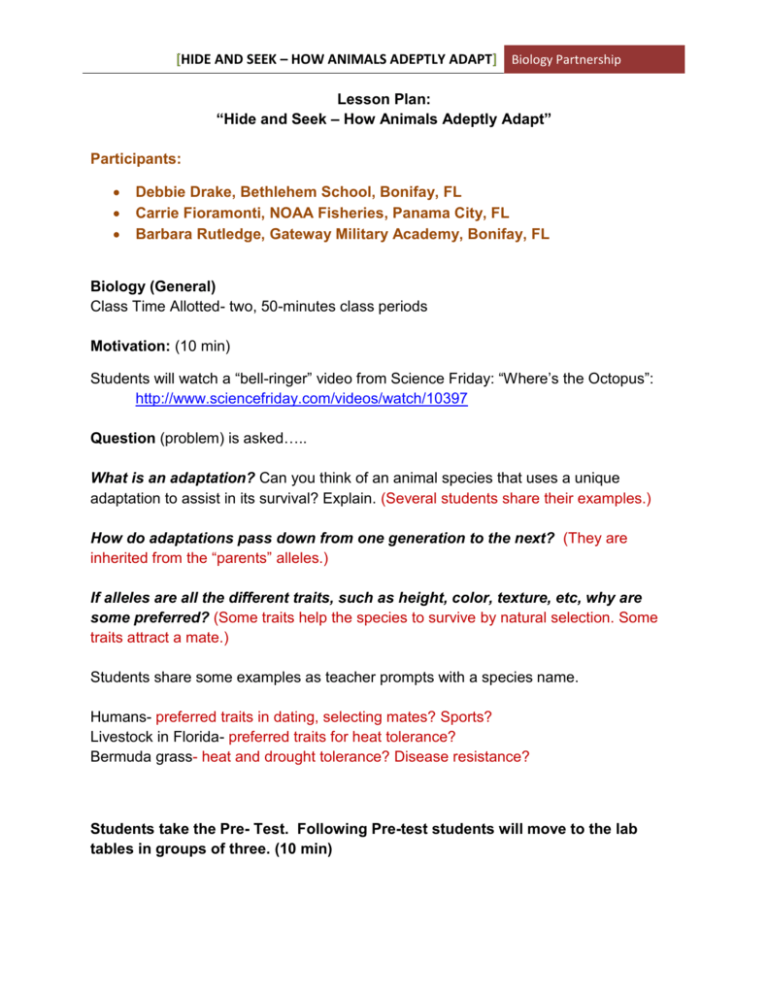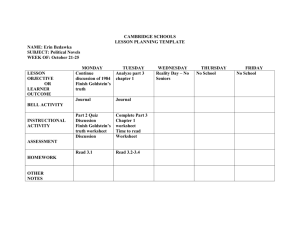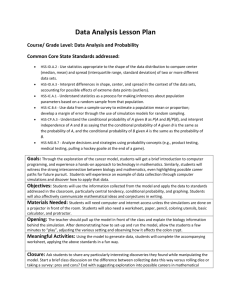Hide and seek * How animals Adeptly adapt
advertisement

[HIDE AND SEEK – HOW ANIMALS ADEPTLY ADAPT] Biology Partnership Lesson Plan: “Hide and Seek – How Animals Adeptly Adapt” Participants: Debbie Drake, Bethlehem School, Bonifay, FL Carrie Fioramonti, NOAA Fisheries, Panama City, FL Barbara Rutledge, Gateway Military Academy, Bonifay, FL Biology (General) Class Time Allotted- two, 50-minutes class periods Motivation: (10 min) Students will watch a “bell-ringer” video from Science Friday: “Where’s the Octopus”: http://www.sciencefriday.com/videos/watch/10397 Question (problem) is asked….. What is an adaptation? Can you think of an animal species that uses a unique adaptation to assist in its survival? Explain. (Several students share their examples.) How do adaptations pass down from one generation to the next? (They are inherited from the “parents” alleles.) If alleles are all the different traits, such as height, color, texture, etc, why are some preferred? (Some traits help the species to survive by natural selection. Some traits attract a mate.) Students share some examples as teacher prompts with a species name. Humans- preferred traits in dating, selecting mates? Sports? Livestock in Florida- preferred traits for heat tolerance? Bermuda grass- heat and drought tolerance? Disease resistance? Students take the Pre- Test. Following Pre-test students will move to the lab tables in groups of three. (10 min) [HIDE AND SEEK – HOW ANIMALS ADEPTLY ADAPT] Biology Partnership PRE-TEST/ POST-TEST Name____________________________ Biology : Population Genetics 1. Charles Darwin spent much of his time as a naturalist studying the unique species A) on the New Hebrides Islands B) in the Baltic Sea. C) in the Arctic Circle. D) on the Galapagos Islands. 2. Unlike natural selection, artificial selection involves _______________________. A) the breeding of organisms for desired traits in the offspring. B) an attempt to breed two different species of animals. C) allowing organisms to breed and produce offspring at random. D) controlled breeding to keep a species from over-populating. 3. A population that is ______________ is not evolving. A) experiencing genetic drift B) isolated geographically C) experiencing genetic equilibrium D) part of the gene pool 4. An equal amount of drought-resistant wild petunias and regular petunias grow in a field. Following a year of severe drought, the seeds produced are at a ratio of 69% drought resistant petunias and 31% regular petunias. The following year will likely produce many more drought resistant petunias than regular petunias. This is referred to as ____________________. A) artificial selection. B) genetic equilibrium. C) natural selection. D) mimicry. 5. A disruption in genetic equilibrium can occur by ______________when the frequency of certain alleles is changed due to chance events. A) Gradualism B) Camouflage C) Adaptive radiation D) Genetic drift 6. To an evolutionist, which of these statements is true? A) Using anatomy studies to find evolution is a direct process. B) Fossils do not play a major role in understanding the evolutionary process. [HIDE AND SEEK – HOW ANIMALS ADEPTLY ADAPT] Biology Partnership C) Major fossil finds are only located in Africa and Antarctica D) Although incomplete, fossil records provide evidence that evolution has occurred. 7. Which adaptation best defines “mimicry”? A) An adaptation that allows one species to look similar to another species B) An adaptation that enables bacteria to resist penicillin C) An adaptation that allows a species to blend into its surroundings D) An adaptation that allows frogs to breathe through their skin 8. A desert plant in Mexico has the ability to suddenly sprout green leaves after a rain. A similar looking plant in an African desert does the same. An evolutionist refers to this as ______________________. A) Adaptive radiation B) Convergent evolution C) Reproductive isolation D) Divergent evolution 9. Evolution infers which of the following regarding the group of structures below? A) They are analogous. B) They are vestigial structures. C) They are unrelated in any way. D) They are homologous. 10. Multiple colors of rabbits exist on an island. When the hawk population increases, what is likely to change when lighter colored rabbits diminish due to their lack of camouflage adaptation? A) The frequency of the allele for “white” in the total population will probably decrease. B) The frequency of all alleles in the population will remain the same. C) The frequency of the brown allele will decrease to stabilize the frequency of white alleles. D) The allele for white will be eliminated from the entire population of rabbits. 11. Birds and bats both have wings. Although the wings serve the same function, they are not evidenced as coming from a common ancestor. These structures are considered ____________________. [HIDE AND SEEK – HOW ANIMALS ADEPTLY ADAPT] Biology Partnership A) B) C) D) analogous structures. vestigial structures. unrelated in any way. Homologous structures. 12. A whale has pelvic bones (hip) that do not appear to have any significant function. An evolutionist infers that such a structure is evidence that the whale may have evolved from a related land animal that walked. These left over structures are referred to as _________________. A) analogous structures. B) vestigial structures. C) unrelated in any way. D) Homologous structures. 13. Which of the following is an example of a physiological adaptation? A) Antibiotic resistance B) Camouflage C) Genetic flow D) Embryology 14. A researcher studies the embryonic photos of several species and notices some striking similarities or shared features among them. What might the researcher deduce from seeing these similarities that would appear to support evolution? ___________________________________________________________________________ _____________________________________________________ 15. Name two different organisms and identify their unique structural adaptations. __________________- _____________________________________________ __________________- _____________________________________________ [HIDE AND SEEK – HOW ANIMALS ADEPTLY ADAPT] Biology Partnership Materials Needed Part 1: Evidence of Evolution Each student will receive the following and work in pairs: o o Evidence of Evolution Worksheet Vocabulary Worksheet Following completion of the worksheet and a portion of the vocabulary worksheet students will move to lab tables in groups of four per table. Each work group will be supplied the following: Bunny Beans Activity: o o o o o 100 pinto beans, 100 navy beans per station 1 brown paper (or opaque bag) per station Colored pencils (one box) and Bunny Beans data worksheets (4) Small shallow container to hold unused beans Calculator (1) Part 2: Mechanism of Evolution Each student will receive the following and work in pairs: o o Mechanisms of Evolution Worksheet (Students should still possess the Vocabulary Worksheet ) Following completion of the worksheet and a portion of the vocabulary worksheet students will move to lab tables in groups of four per table. Each work group will be supplied the following: M&Ms Genetic Drift Activity: o o o o o o . Mechanisms of Evolution Worksheet (4) Vocabulary Worksheet (same worksheets as in Part 1) (4) 1 individual snack size bag of M&Ms per group Paper towel (1 sheet) M&Ms Data worksheet (4) Calculator (1) [HIDE AND SEEK – HOW ANIMALS ADEPTLY ADAPT] Biology Partnership WATER SOURCE Science Lab Setup: Work table Lab Table Supply Table Lab Table Lab Table Lab Table STUDENT DESKS Outcomes [HIDE AND SEEK – HOW ANIMALS ADEPTLY ADAPT] Biology Partnership Dimensions of K-12 Science Education Standards: Scientific and Engineering Practices: 1. Asking questions and defining problems 3. Planning and carrying out investigations 4. Analyzing and interpreting data 5. Using mathematics and computational thinking 7. Engaging in argument from evidence 8. Obtaining, evaluating and communicating information Crosscutting Patterns: 1. Patterns 7. Stability and change Disciplinary Core Ideas: Life Science LLS3- Heredity: Inheritance and variation of traits LLS4 Biological Evolution: Unity and diversity Next Generation Sunshine State Standards: SC.912.N.1.3 Recognize that the strength or usefulness of a scientific claim is evaluated through scientific argumentation, which depends on critical and logical thinking, and the active consideration of alternative scientific explanations to explain the data presented. SC.912.N.1.6 Describe how scientific inferences are drawn from scientific observations and provide examples from the content being studied. SC.912.L.15.13: Describe the conditions required for natural selection, including: overproduction of offspring, inherited variation, and the struggle to survive, which result in differential reproductive success. SC.912.L.15.14: Discuss mechanisms of evolutionary change other than natural selection such as genetic drift and gene flow. Content Literacy Standards (Common Core…Reading Standards for Literacy in Science and Technical Subjects 6-12) Grades 9-10: 4. Determine the meanings of symbols, key terms, and other domain-specific words and phrases as they are used in a specific scientific or technical context relevant to grades 9-10 texts and topics. 5. Analyze the structure of the relationships among concepts in a text, including relationships among key terms. [HIDE AND SEEK – HOW ANIMALS ADEPTLY ADAPT] Biology Partnership Review of 6-8: 9. Compare and contrast information gained from experiments, simulations, video or multimedia sources with that gained from reading a text on the same subject. Specific Learning Outcomes: 1) Working in pairs, students will interactively read and successfully complete all answers to questions on worksheets and define terms on the topics of Evidence of Evolution and the Mechanisms of Evolution. Students should be able to complete the worksheet during class time, but will be expected to complete any unfinished portions on their own. The worksheets will be turned in for credit and promptly returned for use as study guides for testing. 2) Individually and as homework, students will list and define the four (4) Principles of Natural Selection on a Main Idea Web, and list and give examples of the Evidence of Evolution on a Concept Map. The Idea Web and Concept Map will be reviewed at beginning of next class period for clarity. Students will turn in for credit with a minimum of 80% accuracy and promptly returned for use as study guides for testing. 3) Working in groups of 3 -4, students will participate in the Bunny Beans activity. They will execute the activity, record data, and draw conclusions based upon the results on a data worksheet. Using the acquired information, based on data collected, students will analyze and answer questions with 80 % accuracy. Each student will turn in their own complete data worksheet with independent conclusion by the start of the next class session. 4) Working in pairs, students will participate in the M&M activity. They will execute the activity, record data, and make inferences based upon the results on a data worksheet. Using the acquired information, based on data collected, students will analyze and answer questions with 80 % accuracy. Each student will turn in their own complete data worksheet with independent conclusion by the start of the next class session. 5) At the conclusion of Part 2, students will write a laboratory report on one of the activities that includes Introduction, Methods, Results, and Conclusion sections. The students will be required to score acceptably based upon a rubric. [HIDE AND SEEK – HOW ANIMALS ADEPTLY ADAPT] Biology Partnership Presentation and Participation The Evidence of Evolution Part 1 Behavior: Lecture (5 minutes) Present the students with the “Where’s the Octopus” video. Briefly introduce the concept of evolution as a gradual change in a population over time. Cognitive: Thinking Activity (5 minutes) See if the students can hypothesize about how the octopus may have come to be able to do that! See if they can come up with the concept of natural selection on their own. Behavior: Seeking out answers to questions (15 minutes) Students will follow along the Part 1: Evidence of Evolution worksheet as it is explained by the teacher. As vocabulary is introduced, students will complete the definitions on their term sheet. Students will give short answers to questions. Main Idea Web and Concept Map (including within the Evidence of Evolution worksheet) will be homework. Answers will be presented by group members and verified by the teacher. Application/ Process: Bunny Beans- Natural Selection Activity (25 minutes) May not get to Conclusions section during this timeframe. Complete at beginning of next class period. The Mechanisms of Evolution Part 2 Behavior: Clarification (15 minutes) Review the Idea Web homework sheets Review Conclusions from Bunny Beans Activity. Behavior and Cognitive: Seeking out answers to questions (15 minutes) Students will follow along the Part 2: Mechanisms of Evolution worksheet as it is explained by the teacher. As vocabulary is introduced, students will complete the definitions on their term sheet. Students will give short answers to questions. Answers will be presented by group members and verified by the teacher. Application: M&Ms (20 minutes) [HIDE AND SEEK – HOW ANIMALS ADEPTLY ADAPT] Biology Partnership Questions List four (4) pieces of evidence for evolution. Discuss why each piece of evidence supports the theory of evolution. Criticize one piece of evidence for evolution. List four (4) components of natural selection as a mechanism for evolution. Discuss why each component gives rise to the mechanism of natural selection. Criticize one of these components of natural selection as a mechanism for evolution. Compare/contrast structural and physiological adaptations. Give three (3) examples of each. Explain how/why bacteria are becoming resistant to antibiotics. Compare/contrast mimicry and camouflage. Explain why the peppered moth population transitioned from light to dark colored moths during the Industrial Revolution? And how did cleaning up the environment allow for a reversal in this trend What is the function of a vestigial structure (trick question!) List some vestigial structures, what their former function may have been and why that structure has been “lost”. What would happen if all bacteria became resistant to antibiotics? What can we do to prevent this from happening? Pick an organism and explain the benefit of that animal or plant mimicking another. Propose how this leads to natural selection in that organism. Describe the genetic drift as a mechanism for evolution. Give two examples. Give three (3) examples/types of natural selection. Explain how natural selection acts on variations to cause changes in the population. Construct a graph to describe the changes in the population over time. Explain how genetic drift is different from natural selection. [HIDE AND SEEK – HOW ANIMALS ADEPTLY ADAPT] Biology Partnership Reflection Written formative assessments will take place through worksheets and the Post test. Formative assessment will also occur throughout the lesson as the teacher circulates and asks questions. Verbal feedback will be provided to groups throughout the lesson based on their work and their answers to the teacher’s questions. For the summative assessment, students will individually write a “lab report” in the form of short essay questions at the conclusion of the Bunny Beans activity. Students will receive written feedback in the form of teacher comments. Safety A standard lab safety chart is posted in the classroom, and rules are addressed by the teacher before lab activities. General: Instruct students not to handle materials on the lab tables until told to do so. M&Ms Plain M&Ms will be used NOT peanut—to avoid nut allergies Genetic drift bunny/beans: Students will be provided small containers on the desk top for beans. The teacher will instruct students to pick up any spilled beans to prevent slippage. Students are instructed not to place the beans in their mouths. [HIDE AND SEEK – HOW ANIMALS ADEPTLY ADAPT] Biology Partnership Transformative: (Accommodations for at least 2 special needs students) 1. For an ELL/ESOL learner, we could reduce the quantity of vocabulary words required for successful completion of the vocabulary worksheet. For select words the learner would be encouraged to include an appropriate illustration/drawing. 2. ADD/ADHD students may complete the worksheets with a learning partner who can assist with staying on task in a timely manner. 3. For an auditory learner, the teacher could administer the post-test aloud. Utilize After reviewing grades and missed questions on the pre and post exams, determine what if any concepts need to be readdressed and with whom. Typically, students realize that natural selection is the process that results in evolutionary change, yet often state that an organism evolves purposely to meet or satisfy a new need. Populations evolve, not individuals. The environmental “selection” that occurs as part of this process is not a purposeful selection of traits by the environment, but a result of the complex interactions between organisms and their environment over many, many years. When reviewing the lab reports concentrate on scientific process thinking and the reallife applications proposed by the students. Address concerns to individuals, small groups and the whole class if necessary. Strengths from the lab reports should be recognized in class. It is usually a good idea to assign (or volunteer) a couple of students who are competent with graphing and basic data analysis the role of “data expert” for a specific time period. So when a student has trouble graphing data, the student is encouraged to check with one of the classes’ “data and/or graphing experts”. This will better allow the teacher more time to answer content related questions.



